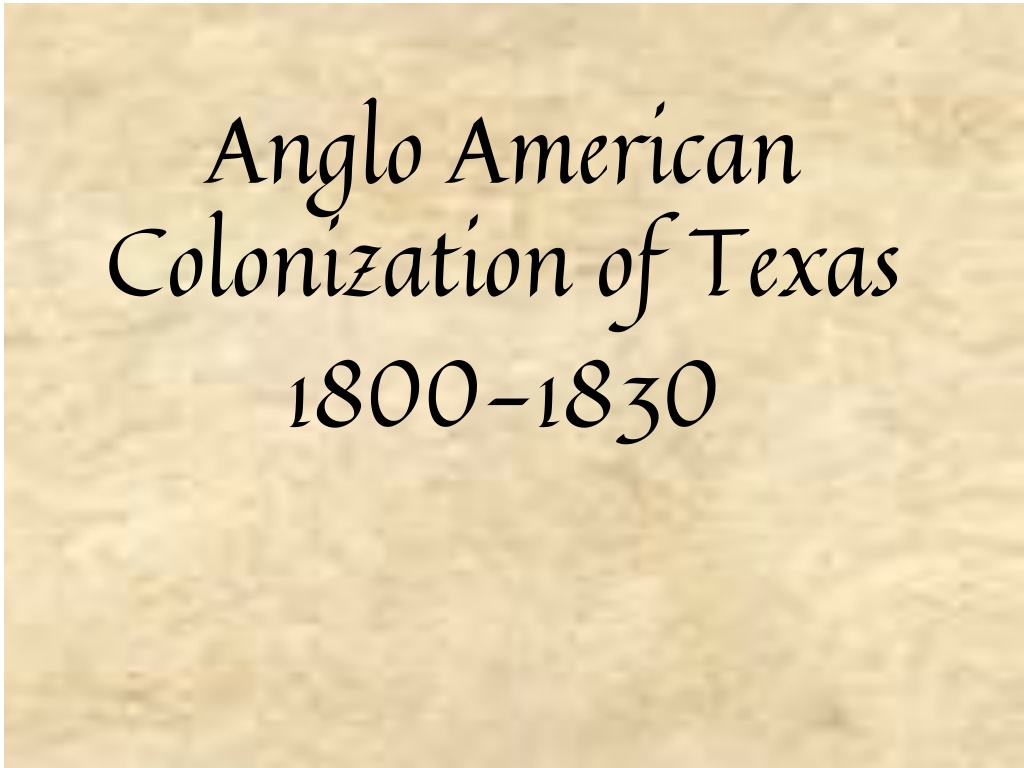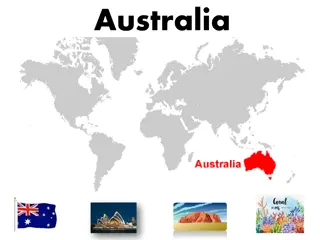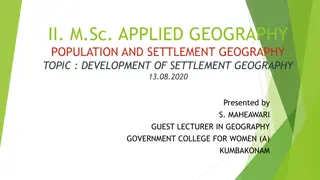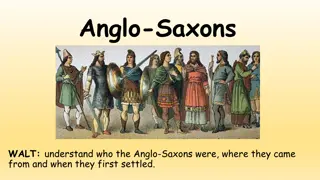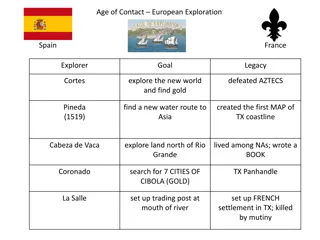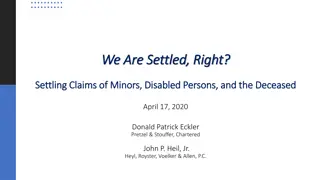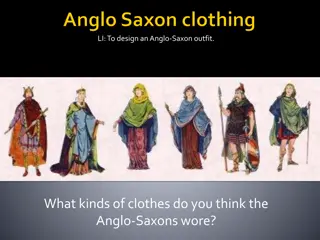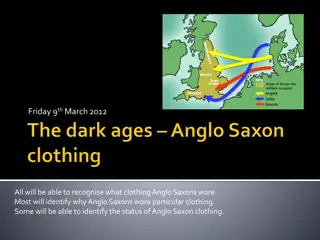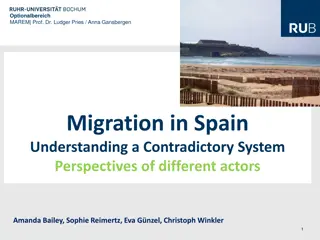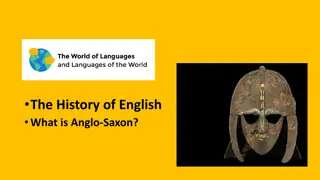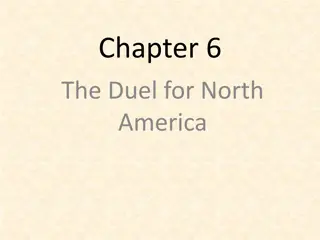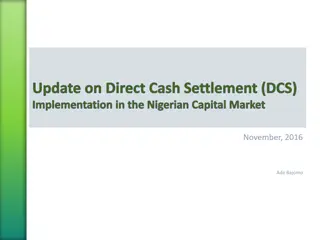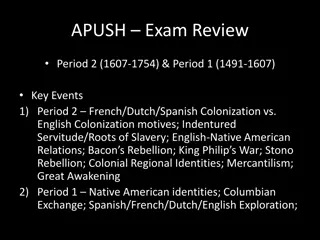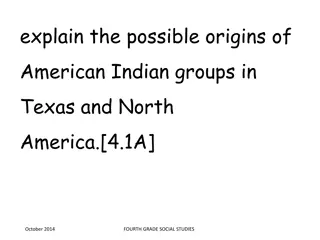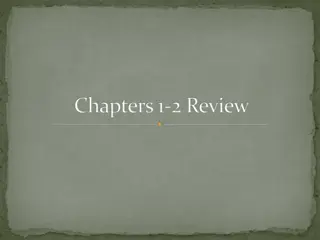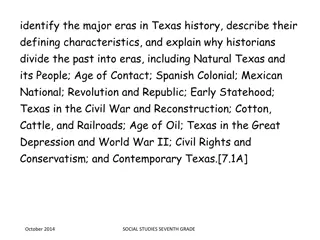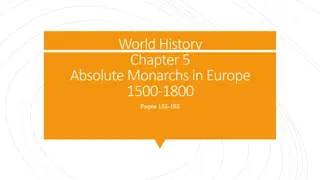Anglo-American Colonization of Texas: Settlement and Control by Spain
Anglo-Americans began moving westward after the United States gained independence, leading to an increased interest in Texas due to its abundant land and opportunities. However, Spain sought to control American immigration by offering land grants with conditions such as pledging loyalty and converting to Catholicism. George Morgan became the first empresario to recruit settlers and establish colonies, with Moses Austin initiating further colonization efforts in the region.
Download Presentation

Please find below an Image/Link to download the presentation.
The content on the website is provided AS IS for your information and personal use only. It may not be sold, licensed, or shared on other websites without obtaining consent from the author. Download presentation by click this link. If you encounter any issues during the download, it is possible that the publisher has removed the file from their server.
E N D
Presentation Transcript
Anglo American Colonization of Texas 1800-1830
Americans Move West After the United Sates gained its freedom from Great Britain in 1783, Anglo Americans began searching for new areas to settle. Some Americans ventured across the Mississippi River. They dreamt of new homes in the West. Anglo Americans People whose ancestors moved from one of many European countries to the United States and who now share a common culture and language.
Why were settlers coming to Texas? They were attracted to the plentiful and inexpensive land. They were seeking adventure and personal gain. They sought escape from problems in the United States. www.txlandandcountry.com/ browne/browne03.jpg
Americans Move West Authorities in New Spain wanted to stop the U.S. government from claiming land west of the Mississippi River. New Spain was afraid that if Americans came West, they would outnumber the Spaniards and take over.
Spain Controls Immigration Initially, Spain tried to control the movement of American immigrants by allowing Anglo Americans to settle in Missouri on generous land grants IF they agreed to: 1. pledge their loyalty to the Spanish government 2. become Catholics (many were not)
Spain Controls Immigration By making the settlers agree to the two conditions, Spain hoped: to populate the area to extend Spanish rule and the new settlers would help prevent other Anglo Americans from entering the territory illegally.
Spain Controls Immigration Under this plan, George Morgan became the first empresario to recruit settlers from the U.S. and be responsible to Spanish authorities for them. empresario an agent who makes all arrangements to bring settlers to a colony In 1787, Morgan founded New Madrid, which is now Missouri.
MOSES AUSTIN BEGINS COLONIZATION IN TEXAS Moses Austin was from Connecticut. Austin was interested in lead mining. After hearing about George Morgan s colony in current-day Missouri, Moses Austin moved there to operate a lead mine. www.dallashistory.org/.../ texas/colonization.htm
MOSES AUSTIN BEGINS COLONIZATION IN TEXAS Initially things went well for Austin until he lost his fortune and was deep in debt. He decided that helping colonists locate in Texas was a good way to make money and pay off his debt.
MOSES AUSTIN BEGINS COLONIZATION IN TEXAS He wanted to bring 300 US families to Texas. Moses Austin presented a petition to the Spanish government.
MOSES AUSTIN BEGINS COLONIZATION IN TEXAS Believing his petition was going to be approved, Moses Austin headed east to start recruiting colonists for Texas. He became ill and was dying when he learned that his petition was officially approved by the Spanish officials. On his deathbed, Austin asked his son, Stephen F. Austin, to carry out his dream of colonizing Texas. www.dallashistory.org/.../ texas/colonization.htm
STEPHEN F. AUSTIN At 27, Stephen F. Austin put aside his plans of practicing law and went to Texas to fulfill his father s wishes. Austin s first visited San Antonio de Bexar and met with Governor Martinez. Governor Martinez appointed Erasmo Seguin (a well-known and respected citizen) to help Austin. photo at www.pbs.org/weta/thewest/ people/a_c/austin.htm
STEPHEN F. AUSTIN Where would Austin put these colonists he was bringing to Texas? Austin s first job was to choose a site for his colony. He chose the area between Lavaca and San Jacinto Rivers. area easy for settlers to clear received enough rainfall for crops area good to grow sugar cane, cotton, corn, and other familiar crops photo at http://www.texas.discodesigns.com/texas/austin/index.shtml
Austin traveled to New Orleans to recruit colonists. Austin looked for people who were willing to accept hard times and could provide for themselves. Remember, these colonists had to agree to be Catholic and loyal to Spain. According to the grant, Austin could bring 300 families to Texas.
The Old Three Hundred By 1824, Austin had 297 families and single men who had received land in his colony. These settlers were infamously known as THE OLD THREE HUNDRED. Among the 1,790 colonists in 1825 about 440 were slaves of African and Caribbean decent. These colonists were very well educated and law abiding and many came from the southern U.S. including several from Louisiana. Some women even held land grants in Austin s colony which was untraditional for that time. One of the most influential was Jane Long, the widow of James Long.
Settlers Arrive in Texas Beginning in 1821, settlers came to Texas. Austin purchased a small vessel named Lively to transport the colonists. Some colonists landed at the wrong river (the Brazos, instead of the Colorado) and didn t see Austin. These colonists were frustrated and returned back to their homes in New Orleans.
Characteristics of The Old Three Hundred Old Three Hundred mostly U.S. southerners mostly farmer s many slaveholders mostly law-abiding fairly well educated
OLD THREE HUNDRED Settlers who were farmers received one labor, or 177 acres. Settlers who raised cattle received a sitio, or a square league of 4,428 acres. Many settlers received both. Once the settlers were selected to come to Texas, they were given land titles, or proof of ownership of the land.
Austins Leadership The first years in the colony were tough. drought attacks by Karankawas many colonists returning to the United States Austin s colony was successful. This success was due to Austin s leadership.
Once Austin found out that Mexico had gained its independence from Spain, he traveled over 1,000 miles to Mexico to obtain permission for his colony. After a year, he received the approval of the Mexican government for his colony. During this year, Austin learned to speak Spanish and won the trust of Mexican officials.
Austin deals successfully with Mexican leaders. Austin was awarded grants under national colonization laws. Austin influenced laws that freed colonists from taxes. Austin also obtained homestead rights for the colonists. These rights meant that settlers land and tools could not be seized to pay back a debt.
Mexicos New Colonization Laws National Colonization Law of 1824 -allowed each Mexican state to set its own colonization policies -restricted new U.S. immigrants from establishing colonies near the borders or the coast State Colonization Law of 1825 -Empresarios received 67,000 acres of land for every 200 families - heads of household received 4,428 acres of land for $30 and exempt from paying taxes for 10 years Effects on Settlement in Texas -huge wave of immigration, particularly U.S. immigration to Texas -several new colonies established
Early Problems in Austin s Colony Stephen F Austin returned to his colony in August 1823 along with Baron Bastrop to issue the official land titles. He found that several settlers had already left and others were threatening to leave. Major droughts had ruined many of the first crops and raids by the Karankawa and Tonkawa Indians left little food and supplies.
Austins Reaction to the Troubles To reassure the settlers that they belonged in Texas and to regain their support, Austin established a central government near La Grange including a mixture of U.S. and Mexican laws by which to govern. He also set up a militia and launched several attacks against the Texas Indians. He eventually failed at establishing peaceful relations with the Indians.
San Felipe de Austin In 1824 Stephen F. Austin founded San Felipe de Austin as the capital of his colony. It was located along the Brazos River almost directly in the center of the colony. San Felipe soon became a booming success as many people moved to the capital. By the 1830 s, it was the second largest business center (next to San Antonio). The town housed a newspaper, a lumber mill, a post office and a hotel Austin s Colony WAS A SUCCESS!!
Austins Other Colonies Austin, with the help of Erasmo Seguin and other Tejano leaders, founded four other colonies. Several of these overlapped his original colony. One colony stood alone and was later known as Austin s Little Colony. The main town was Bastrop. Austin s Little Colony suffered several Comanche raids due to it s location (right next to the Indians hunting grounds) and never managed success. My ambition has been to succeed in redeeming Texas from it s wilderness by means of the plow alone in by doing this I hoped to make the fortune of thousands and my own amongst the rest. -Stephen F. Austin (per Gregg Cantrell)
Stephen F Austins Contributions to Texas Over 40 Empresarios were granted land during the 1820 s and the population increased from a mere couple thousand to 21,000 by 1834. Stephen F Austin alone was responsible for bringing more than 1,500 families to Texas. He had the ability to get along with almost everyone he met including Mexican officials and Indian leaders He will forever be known as The Father of Texas
Mexican Land Grants, 1821-1836 If you were an empresario, which land grant would you have wanted and why?
Expanding the Empresarial System Although Stephen F. Austin became known as the first real empresario in Texas, he was not the only one. The state colonization law of 1825 allowed other empresarios to receive land grants in Texas. By 1830, about 30 people were recruiting colonists to Texas.
Expanding the Empresarial System The second most important empresario was Green DeWitt. DeWitt founded a colony southwest of Austin s original grant. DeWitt s headquarters were in Gonzales. Although DeWitt had permission to bring 400 settlers to Texas, he had only really settled 166 settlers.
Other Empresarios Martin de Leon- was the only Mexican empresario to found a Texas colony made up of primarily Mexican settlers. Lorenzo de Zavala- was active in Mexican politics and received a grant to settle 500 families in East Texas. He sold the land before establishing the colonies
TEXAS IN 1830 Population in Texas was almost 20,000 people. Towns of La Bahia and Nacogdoches had grown considerably. There were new towns in San Felipe, Gonzales, and Victoria. There were many other smaller communities. The cotton and cattle industries were growing. Working together, the Mexican government, the empresarios, and the settlers would continue to expand Texas population.
What did you Learn?? 1. Where did most of the Old Three Hundred come from and what did they all have in common? - Most were from the Southern U.S. They were mainly well educated, law abiding farmers and many were slaveholders. 2. How did Austin and the other empresarios affect settlement in Texas? - They brought many immigrants particularly U.S. citizens to Texas, increased the population by setting up colonies and towns.
